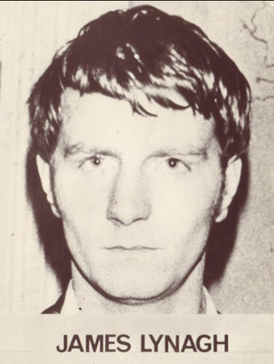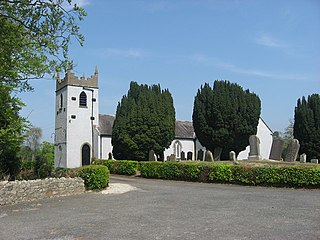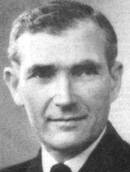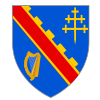
The Royal Ulster Constabulary (RUC) was the police force in Northern Ireland from 1922 to 2001. It was founded on 1 June 1922 as a successor to the Royal Irish Constabulary (RIC) following the partition of Ireland. At its peak the force had around 8,500 officers, with a further 4,500 who were members of the RUC Reserve.

The East Tyrone Brigade of the Provisional Irish Republican Army (IRA), also known as the Tyrone/Monaghan Brigade was one of the most active republican paramilitary groups in Northern Ireland during "the Troubles". It is believed to have drawn its membership from across the eastern side of County Tyrone as well as north County Monaghan and south County Londonderry.

Tynan is a village, townland and civil parish in County Armagh, Northern Ireland. It is situated largely in the historic barony of Tiranny, with some areas in the barony of Armagh, around 11 kilometres (7 mi) west of Armagh City.

Killylea is a small village and townland in Northern Ireland. It is within the Armagh City and District Council area. The village is set on a hill, with St Mark's Church of Ireland, built in 1832, at its summit. The village lies to the west of County Armagh, and is close to the neighbouring counties of County Tyrone and County Monaghan which is in the Republic of Ireland. It had a population of 253 people in the 2011 Census.

Caledon is a small village and townland in County Tyrone, Northern Ireland. It is in the Clogher Valley on the banks of the River Blackwater, 10 km from Armagh. It lies in the southeast of Tyrone and near the borders of County Armagh and County Monaghan. It is situated in the historic barony of Dungannon Lower and the civil parish of Aghaloo. In the 2001 Census it had a population of 387 people. It is a designated conservation area. It was historically known as Kinnaird.

James 'Jim' Lynagh was a member of the East Tyrone Brigade of the Provisional Irish Republican Army (IRA), from Monaghan Town in the Republic of Ireland, who was killed by British special forces while attacking a police station.

Sir Charles Norman Lockhart Stronge, 8th Baronet, MC, PC, JP was a senior Ulster Unionist Party politician in Northern Ireland.
Major James Matthew Stronge was a soldier and Ulster Unionist Party MP in the Parliament of Northern Ireland, and the later Northern Ireland Assembly. He was the son and heir of Sir Norman Stronge, Bt; they were both killed by the Provisional Irish Republican Army at his family home, Tynan Abbey.
The Stronge baronetcy of Tynan was conferred in the Baronetage of the United Kingdom on 22 June 1803. The family were northern Irish landowners of Tynan Abbey, County Armagh, also possessing the residence of Lizard Manor, Aghadowey, County Londonderry.

Ballymascanlan, otherwise Ballymascanlon, is a small village and townland in County Louth, Ireland, situated 4 km north-east of Dundalk on the Cooley Peninsula, on the road to Carlingford.
The Troubles in Lurgan recounts incidents during the Troubles in Lurgan, County Armagh, Northern Ireland.

Sir James Henry Stronge, 5th Baronet was an Irish barrister, footballer and politician.

Sir James Matthew Stronge, 3rd Baronet DL, JP, succeeded to the baronetcy on the death of his 78-year-old father, Sir James Stronge 2nd baronet, on 2 December 1864. He was a member of the Stronge family and was born in Tynan Abbey, County Armagh. His mother was Isabella Calvert, Lady Stronge, the eldest daughter of Nicholas Calvert M.P., of Hunsdon House, Hertfordshire, and his wife The Hon. Frances Pery, daughter of the Viscount Pery.

Rev. Sir James Stronge, 1st Baronet was born in Tynan Abbey, County Armagh, Ireland. Tynan Abbey was built by his father.

Captain Frederick Michael Alexander Torrens-Spence, was a Royal Navy Fleet Air Arm pilot in the Second World War. Torrens-Spence earned the distinction of holding commissions in the Royal Navy, the Royal Air Force, the British Army and the Royal Ulster Constabulary.

Mid Armagh was a constituency of the Parliament of Northern Ireland.

The Tullyvallen massacre took place on 1 September 1975, when Irish republican gunmen attacked an Orange Order meeting hall at Tullyvallen, near Newtownhamilton in County Armagh, Northern Ireland. The Orange Order is an Ulster Protestant and unionist brotherhood. Five Orangemen were killed and seven wounded in the shooting. The "South Armagh Republican Action Force" claimed responsibility, saying it was retaliation for a string of attacks on Catholic civilians by Loyalists. It is believed members of the Provisional IRA carried out the attack, despite the organisation being on ceasefire.
Ballymoyer House, now demolished, was an 18th-century country house which stood in a 7000-acre demesne in the townland of Ballintemple, some 5 km north east of Newtownhamilton, County Armagh, Northern Ireland.
The destruction of country houses in Ireland was a phenomenon of the Irish revolutionary period (1919–1923), which saw at least 275 country houses deliberately burned down, blown up, or otherwise destroyed by the Irish Republican Army (IRA). The vast majority of the houses, known in Ireland as big houses, belonged to the Anglo-Irish upper class known as the Protestant Ascendancy. The houses of some Roman Catholic unionists, suspected informers, and members or supporters of the new Irish Free State government were also targeted. Although the practice by the IRA of destroying country houses began in the Irish War of Independence, most of the buildings were destroyed during the Irish Civil War (1922–23). Today, most of the targeted buildings are in ruins or have been demolished. Some were restored by their owners, albeit often smaller in size, or were later rebuilt and re-purposed.














